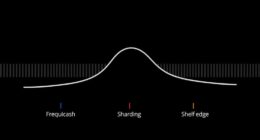Convolution reverbs use real impulse responses to create highly realistic and natural-sounding space effects, but they require more processing power and offer limited flexibility once chosen. Algorithmic reverbs generate effects through mathematical algorithms, making them more efficient and easier to tweak for creative control. If you want authentic room ambiance or versatile sound design, convolution might be best. For quicker, customizable effects, algorithmic is a solid choice—explore further to see which suits your needs.
Key Takeaways
- Convolution reverb uses real-world impulse responses for natural, authentic sound, while algorithmic reverb generates effects through mathematical algorithms.
- Convolution offers highly realistic reverberation but requires significant processing power, whereas algorithmic reverb is more efficient and flexible.
- Algorithmic reverb allows real-time parameter adjustments for creative control; convolution IRs are less adjustable once selected.
- Convolution excels in space-specific applications like realistic room or hall effects, while algorithmic reverb is ideal for quick, customizable effects.
- The choice depends on the need for realism versus flexibility and system resources available.

When choosing reverb effects for your audio projects, understanding the difference between convolution and algorithmic reverbs can make a significant impact on your sound. Convolution reverb relies on impulse responses—recorded acoustic snapshots of real spaces—that are used to recreate authentic reverberations. These impulse responses capture the unique characteristics of a room, hall, or environment, allowing you to add realistic ambience to your mix. When you select convolution reverb, you’re fundamentally applying a detailed acoustic signature to your audio, resulting in a natural, immersive sound. However, this process involves significant computational complexity because it requires convolving your audio signal with large impulse response files, which can demand considerable processing power, especially with high-resolution or lengthy IRs. This computational load can sometimes lead to latency or reduced performance, particularly on less powerful systems.
On the other hand, algorithmic reverb generates reverb effects through mathematical algorithms designed to simulate the reflections and decay of sound in a space. These reverbs are more flexible, allowing you to tweak parameters like decay time, density, and diffusion in real-time, giving you more control over the sound. Because they don’t rely on pre-recorded impulse responses, algorithmic reverbs typically involve less computational complexity, making them more efficient for real-time processing or situations where you need quick adjustments. They’re ideal for creative effects or when working within limited processing resources. However, while they can produce convincing reverbs, algorithmic reverbs may sometimes sound less natural than convolution, especially if the algorithms are not sophisticated enough or if you don’t spend time fine-tuning the parameters.
Ultimately, your choice depends on your project needs. If you’re aiming for the most authentic, space-specific reverb, convolution reverb with high-quality impulse responses offers unparalleled realism—though at a higher processing cost. If you need versatility, faster processing, and more control, algorithmic reverb might be the better choice. Both types have their place, and understanding their differences—particularly how impulse responses influence convolution reverb and how computational complexity impacts performance—helps you make more informed decisions. By weighing realism against efficiency, you can tailor your reverb selection to achieve the desired ambiance in your mix without overtaxing your system.
Frequently Asked Questions
How Do Convolution and Algorithmic Reverbs Impact Mixing Workflow?
You notice that convolution reverbs, which use impulse responses, provide realistic space but can add processing latency, slowing your workflow. Algorithmic reverbs, on the other hand, process faster and reduce latency, making them ideal for quick adjustments. Your choice impacts how smoothly you work; convolution offers authenticity at the cost of speed, while algorithmic boosts efficiency but may lack some realism. Balancing both depends on your project’s needs.
Can Convolution Reverb Replicate Any Space Accurately?
Convolution reverb can replicate many spaces accurately, thanks to its impulse response accuracy, which captures real-world acoustics precisely. However, it might struggle with complex or unique environments where impulse responses aren’t available or are imperfect. For ideal space realism, convolution reverb excels in reproducing specific spaces, but it’s limited by the quality of the impulse responses. For more flexibility in creating or modifying spaces, algorithmic reverb may be a better choice.
Are There Specific Genres That Benefit More From Either Reverb Type?
Think of your music as a canvas; certain reverb types paint different emotions. For lush, cinematic soundscapes, convolution reverb serves as your detailed brush, ideal for genres like ambient or orchestral, where realism matters. Conversely, algorithmic reverb acts as bold strokes, perfect for genres like electronic or pop that benefit from creative, stylistic effects. Your choice depends on your genre preferences and the mood you want to evoke.
How Do CPU Demands Compare Between Convolution and Algorithmic Reverb Plugins?
You’ll find that algorithmic reverb plugins generally demand less CPU power, making them more computationally efficient for real-time processing. Convolution reverb, on the other hand, requires considerably more CPU resources because it processes complex impulse responses. If you’re working on a project with limited system resources or need real-time effects, algorithmic reverb is your best choice. Convolution reverb offers high fidelity but at the cost of increased CPU load.
What Are the Best Practices for Blending Both Reverb Types?
Think of blending reverb types as mixing paints for a masterpiece. You should start with a solid foundation from convolution reverb, then add splashes of algorithmic reverb for creative layering. Use parameter blending to balance their characteristics, adjusting decay, mix, and pre-delay. Experiment with different levels to find a seamless integration. This approach gives you both realism and creative space, making your soundscape richer and more dynamic.
Conclusion
In the end, choosing between convolution and algorithmic reverbs is like selecting the perfect paintbrush for your masterpiece. Convolution offers a rich, textured tapestry—grounded in reality—while algorithmic reverb lets your creativity run wild, like a free-flowing river. Both can transform your soundscape, but it’s up to you to decide whether you want a mirror of reality or a portal to endless sonic domains. Trust your instincts, and let your music breathe.









